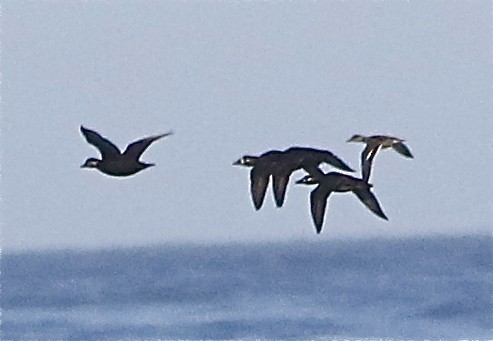Black Scoter
A species of Scoters Scientific name : Melanitta americana Genus : Scoters
Black Scoter, A species of Scoters
Botanical name: Melanitta americana
Genus: Scoters
Content
Description General Info
 Photo By Don Roberson
Photo By Don Roberson Description
This large sea duck is characterised by its bulky shape and large bill. The adult male is all black with a very bulbous bill which is mostly yellow. The female is a brown bird with pale cheeks, very similar to female common scoter. The adult female averages about 980 g (2.16 lb) and 45 cm (18 in) in length, while the adult male is on average 1,100 g (2.4 lb) and 49 cm (19 in) in length. This species can be distinguished from other scoters, apart from common scoter, by the lack of white anywhere on the drake, and the more extensive pale areas on the female. 
Size
41 - 81 cm
Life Expectancy
8- 18 years
Nest Placement
Ground
Clutch Size
8 - 9 eggs
Incubation Period
1 brood
Number of Broods
27 - 28 days
Feeding Habits
During breeding, black Scoter mainly consumes insects, larvae, small mollusks, crustaceans, fish eggs, and aquatic vegetation. In winter, the diet shifts to predominantly shellfish such as mussels and clams, supplemented by crustaceans, polychaete worms, crabs, shrimp, and some marine vegetation.
Habitat
Black Scoter favor boreal forest habitats, nesting by shallow, rocky lakes with emerging vegetation, crucial for brood-rearing. Molting occurs in coastal locations like bays or estuaries. During migration, they make transient inland water stops, while coastal areas with abundant shellfish provide wintering grounds. They associate with seabirds in Pacific zones of herring spawn.
Nest Behavior
Nest building by black Scoter occurs in sedge or grass. Egg incubation and chick rearing are handled by the female alone.
Nest Characteristics
Black Scoter's nest is located within 100 feet of water, in grassy or mossy areas with some cover. The female creates a ground depression lined with down feathers, measuring roughly 9.8 inches wide and 4.9 inches high.
Dite type
Aquatic invertebrate eater
General Info
Feeding Habits
Bird food type
Behavior
Black Scoter's daily life is marked by their strong social bonds, especially during the winter courtship period with intricate displays involving neck stretching, tail raising, splashing rushes, water flicking, preening, and dramatic landings after flight. They choose monogamous pairs on breeding grounds but are characterized by little-studied mating systems. Territorial during this period, black Scoter fiercely guards mates, chasing rivals, and showing aggression with threat displays. Post egg-laying, males leave for molt, and females single-handedly incubate and rear the young.
Distribution Area
The black scoter breeds in the far north of North America in Labrador and Newfoundland to the southeast and northwest of Hudson Bay. It also occurs on the Siberian side of the Bering Straits east of the Yana River. It winters farther south in temperate zones, on the coasts of the northern USA and Canada, on the Pacific coast south to the San Francisco Bay region and on the Atlantic and Gulf of Mexico coasts, and in Asia as far south as China. Some birds may over-winter on the Great Lakes. This species is a very rare vagrant to western Europe; only drakes are safely identifiable out of range, so females are likely to be undetected. 